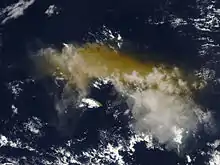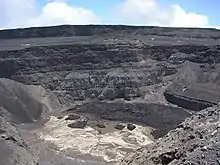Mount Karthala
Mount Karthala or Karthola (Arabic: القرطالة Al Qirṭālah) is an active volcano and the highest point of the Comoros at 2,361 m (7,746 ft) above sea level. It is the southernmost and larger of the two shield volcanoes forming Grande Comore island, the largest island in the nation of Comoros. The Karthala volcano is very active, having erupted more than 20 times since the 19th century. Frequent eruptions have shaped the volcano's 3 km by 4 km summit caldera, but the island has largely escaped broad destruction. Eruptions on April 17, 2005 and May 29, 2006 ended a period of quiet.
| Mount Karthala | |
|---|---|
.jpg.webp) Mount Karthala aerial view. | |
| Highest point | |
| Elevation | 2,361 m (7,746 ft)[1] |
| Prominence | 2,361 m (7,746 ft)[1] |
| Listing | Ultra Country high point |
| Coordinates | 11°45′37″S 43°21′11″E[2] |
| Geography | |
 Mount Karthala | |
| Country | Comoros |
| Island | Grande Comore |
| Geology | |
| Mountain type | Shield volcano (active) |
| Last eruption | January 2007 |
| Official name | Le Karthala |
| Designated | 12 November 2006 |
| Reference no. | 1649[3] |
Volcanic activity

April 2005 eruption

The eruption, which carried a risk of lava flows and deadly volcanic gas, caused the evacuation of 30,000 residents. The crater was clearly changed by the eruption. A grey field of ash surrounds the crater and the caldera itself seems larger and deeper. The crater lake, which formed after Karthala's last eruption in 1991 and once dominated the caldera, is now gone completely. In its place were rough, dark grey rocks, possibly cooling lava or rubble from the collapsed crater.
Flora and fauna
The mountain is covered by intact moist evergreen forest from 1200 metres to about 1800 metres above sea-level. Higher up the vegetation consists of stunted trees and heathland where the giant heather Erica comorensis grows.[5] The mountain's forest is threatened by logging and the spread of agriculture. Many of the species found on the mountain are unique to the Comoros and four bird species are found only on the slopes of Mount Karthala: Grand Comoro drongo, Humblot's flycatcher, Karthala scops owl, and Karthala white-eye.
Important Bird Area
A 14,228 ha (35,160-acre) tract encompassing the upper slopes and summit of the mountain has been designated an Important Bird Area (IBA) by BirdLife International, because it supports populations of Comoros blue pigeons, Comoros fodies, Comoros olive pigeons, Comoros thrushes, Grand Comoro brush warblers, Grand Comoro bulbuls, Grand Comoro drongos, Humblot's flycatchers, Humblot's sunbirds, Karthala scops owls, Karthala white-eyes, and Malagasy harriers.[6]
Karthala National Park
| Karthala National Park | |
|---|---|
| Parc National du Karthala | |
| Coordinates | 11°46′S 43°21′E |
| Area | 26,214 ha (101.21 sq mi) |
| Designation | National park |
| Designated | 2010 |
| Administrator | Comoros National Parks Authority |
| Designated | 12 November 2006 |
| Reference no. | 1649[7] |
Karthala National Park protects an area of 262.14 km2 on the mountain. It was designated in 2010.[8]
See also
Notes
- Listed as "Le Kartala" on Peaklist.org Retrieved 27 September 2011
- Karthala in Geonames.org (cc-by)
- "Le Karthala". Ramsar Sites Information Service. Retrieved 25 April 2018.
- "Comoros volcano tremors grow stronger, more frequent". Reuters. 21 January 2007. Retrieved 25 April 2021.
- Issues in Global Environment—Biology and Geoscience: 2013 Edition. ScholarlyEditions. 1 May 2013. p. 763. ISBN 978-1-4901-0964-0. Retrieved 17 December 2021.
- "Karthala Mountains". BirdLife Data Zone. BirdLife International. 2021. Retrieved 1 March 2021.
- "Le Karthala Ramsar Site". Ramsar Sites Information Service. Retrieved 10 August 2021.
- UNEP-WCMC (2021). Protected Area Profile for Parc National du Karthala from the World Database of Protected Areas. Accessed 10 August 2021.
References
- "Karthala". Global Volcanism Program. Smithsonian Institution.
- "Comoros forests". Terrestrial Ecoregions. World Wildlife Fund. Downloaded 27/02/07.